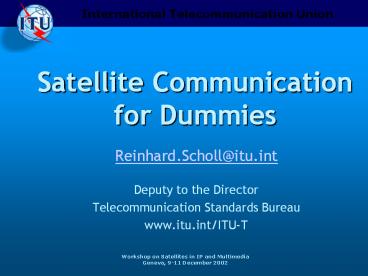Satellite Communication for Dummies - PowerPoint PPT Presentation
Title:
Satellite Communication for Dummies
Description:
International Telecommunication Union. Workshop on Satellites in IP and ... LEOs' Roller Coaster Ride. Early '90s: LEOs reach for the stars. mobile telephony: ... – PowerPoint PPT presentation
Number of Views:881
Avg rating:3.0/5.0
Title: Satellite Communication for Dummies
1
Satellite Communication for Dummies
- Reinhard.Scholl_at_itu.int
- Deputy to the Director
- Telecommunication Standards Bureau
- www.itu.int/ITU-T
2
Contents
- The Market
- The Standards
- The Workshop
3
Satellite Physics
- Geostationary satellites (36,000 km)
- Stay over a fixed point on the ground
- Advantage
- simple
- Disadvantage
- ½ sec for signal-round trip
- because satellite far away, signal is weak when
it hits earth - LEO (low-earth-orbit) satellites
- Advantage shorter delays
- Disadvantage complex
1. The Market 2. The Standards 3. The Workshop
4
Todays Satellite Communication Services
- Voice Trunking
- Mobile telephony
- Broadband Internet
- Digital television
1. The Market 2. The Standards 3. The Workshop
5
Historical Perspective
- The old days
- Communications satellite research deployment
early 60s - Main instrument for transoceanic communications
- Monopolistic markets
- Recent developments
- Liberalization of satellite industry
- Privatization of treaty organizations
- Competition with other transport media
- Fiber for voice/data
- A single strand can carry more data than all
existing satellites combined (acc. to
Telegeography) - Cable for TV-broadcasting
1. The Market 2. The Standards 3. The Workshop
6
LEOs Roller Coaster Ride
- Early 90s LEOs reach for the stars
- mobile telephony
- Iridium, Globalstar, ICO
- Internet-in-the-sky
- Teledesic
- End of 90s LEOs fall back to earth
- Bankruptcies (Ch 11)
- Beginning 2000s LEOs to relaunch more modestly
1. The Market 2. The Standards 3. The Workshop
7
Risks of Satellite Industry
- Long wait between design and profitability
- Many satellites make money only after 10 years in
orbit - Need to build entire network before signing up
the first customer - Manufacturers must lock down technology gt 3 years
before launch - Betting on a market up to 15 years in the future
1. The Market 2. The Standards 3. The Workshop
8
World Satellite Services Revenue
in billion
est.
Subscription/retail services revenues
Transponder leasing revenues
1. The Market 2. The Standards 3. The Workshop
(Source Satellite Industry Association)
44.4
39.2
31.5
22.5
18.3
15.6
10.6
7.2
7.8
7.7
7.2
7.2
6.1
5.7
5.2
1996
1998
1999
2000
1996
2001
2002
9
Where to Go?
- Need for
- differentiating products services
- new markets
- competitive pricing
- Provision of services to end-users
- Broadband bi-directional data (Internet) access
- Sharing of resources to reduce costs ?!
- Customized interfaces / APIs ?!
1. The Market 2. The Standards 3. The Workshop
10
What is Being Done in ITU-T?
- High-level coordination activities
- ICG-SAT coordination between and within ITU-T
and ITU-R activities - Mid- and low-level coordination
- Mediacom2004 (ITU-T SG 16)
- IP Project (ITU-T SG 13)
- Exploring opportunities for synergy with ITU-D
- Important specifications to take satellites into
account
1. The Market 2. The Standards 3. The Workshop
11
Possible Standardization Topics
- Common service definition approach
- Common service interfaces
- Defined user premises equipment and interfaces
- Resources for seamless interconnection across
networks
1. The Market 2. The Standards 3. The Workshop
12
Workshop Objectives
- Examine business cases for satellite services
- Identify standards to be developed which help
satellite industry to make money - Increase awareness of ITU-T and ITU-R related
studies - Coordinate with other SDOs and forums
- Enhance studies on the possibility of use of
satellites for bridging digital divide
1. The Market 2. The Standards 3. The Workshop
13
Thank you to the Steering Committee
- Paolo Amadesi
- Vladimir Androuchko
- Fabio Bigi
- Simao Campos
- Greg Jones
- Sastri Kota
- Chae-Sub Lee
- Yves Montfort
- Brian Moore
- Mark Neibert
- Tolga Ors
- Pierre-Andre Probst
- Reinhard Scholl
- Georges Sebek
- David Weinreich
1. The Market 2. The Standards 3. The Workshop
thank you to numerous ITU staff































